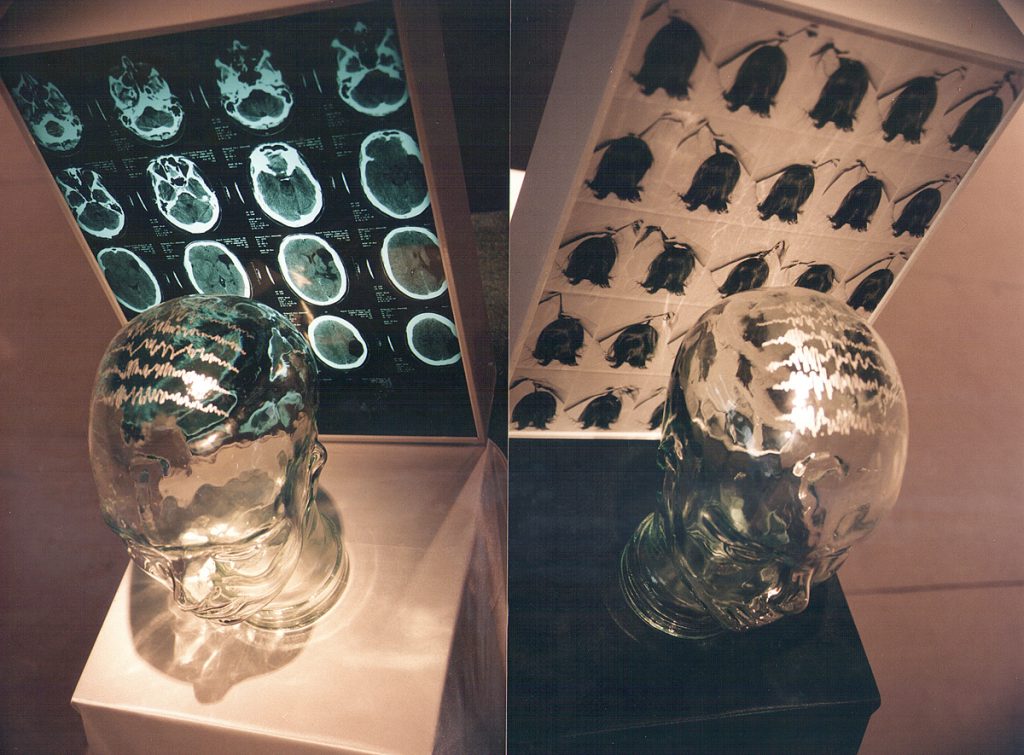
Created for the group exhibition Seize curated by Kellyann Geurts for the National Gallery of Victoria in 1999.
“1987 – Returning to boarding school after the holidays, the kids hid my pills while we were unpacking… forcing me to go to bed without my medication. The next morning after breakfast… they got what they wanted… to see me have a fit. It was the first, last and only time they did it, after they witnessed the implications of their actions.
1989 – At one point I was in emergency at Princess Margaret Hospital, when I started to seizure… as I slipped fully into it, a nurse asked me my name, and I gave it to her while in full tremor.
1991 – I’ve had a seizure at the Perth Train Station. It’s strange to see the reactions of most people when they see something that isn’t normal, that isn’t physically apparent as a disability, and therefore hard to explain and accept. Of the hundreds who walked past, only two people came to my aid as I had that fit. I’ve had fits on my bike and knocked myself unconscious, I’ve had them swimming, at the ballet… all the causes for the fits are from different sources of stress, or medication problems.” Diary entries and notes © John Farrell, who’s story was featured in Headlines.
“She was always isolating single stands of hair from the top of her head, then plucking them out. After a time, there was a sparse, almost bald spot where soft down-like baby hair began to grow. I was constantly fascinated by this repetitive action – could never quite understand why she did it.” Many years later whilst embedded in extensive research for my Masters Degree, I learned that this is an Obsessive Compulsive Disorder known as ‘Trichotillomania’. In remembrance of Dawn Kleemann who passed away after a massive epileptic seizure in 1971.
Catalogue Introduction – Kellyann Geurts
Ancient Greeks named epilepsy the sacred disease mostly to differentiate the condition from mental illness and hysteria. Superstitions and theories have existed throughout history – relating epilepsy with shamanism, prophecy and religious phenomena… Others have adopted sacred disease to conceal ignorance and deny cause. (Fifty per cent of the causes of epilepsies are unknown.) The sacred disease is also associated with genius due to the great number of creative minds that have been afflicted. What may seem to be an ordinary seizure (from a medical perspective), may be interpreted by the individual in the form of art.
Hippocrates was the first to refute the concept of sacredness and concluded that epilepsy was no more than a fluid imbalance in the brain. Scientists believe that the brain’s balance of chemicals (neurotransmitters) do influence our programming – proposing that human mental imbalance is intimately and permanently linked to the chemistry of the brain. A mere chemical reaction?
The strong link between personal suffering and works of art has existed throughout history and is only now being recognised in the current scientific studies. Dr Oliver Sachs stated, at the opening of the Centre for Mind in Canberra in 1997, that clinical neurology is finally starting to address other aspects such as sensibility, imagination and consciousness in relation to traditional studies. He thinks that creativity is most important as it involves the mind and many depths of unconsciousness.
Art & Epilepsy – Russell Pollard, Executive Director, Epilepsy Foundation of Victoria
Epilepsy is something about which few of us ever speak, despite its cumulative incidence being 3% of the community. This exhibition is therefore a wonderful opportunity for us to be able to communicate about epilepsy and its impact on the lives of those who are affected by it. Art has to do with communicating messages. Good art has to do with communicating ideas and creative insight with skill, honesty and integrity so that those seeing or hearing the work can receive something of the artist’s insight, something of value, something that strikes a chord in their own experience of life.
Messages about epilepsy are often difficult to convey, and it is something the Epilepsy Foundation works hard to do well. The messages in this exhibition come through with an almost stinging clarity, and an eloquence which attests to the power of art, and of each of the artists, to share their hard won insights into one of the most misunderstood, and oftentimes feared, aspects of human existence… Epilepsy is not something we should fear. It is something that people can not only rise above, it is something from which people can draw both strength and real human insight.
Seize artists: Sharon Anderson, Daniel Bacon, Glen Brady, Pam Clements, Noella Clohesy, Lindsay Cox, Pam Crane, Isabelle Delmotte, Clementine Docherty, Brendan Doyle, Sharon Flanagan, Kellyann Geurts, Susan Hawthorne, Bernadette Jones, Robert Kirakovski, Pamela Kleemann, Julie-Ann Martin, Ellen Mileo, Margaret Miles, Ian Napier, Damien Orriss, Theo Papathomas, Paul Procee, Natalie Rhook, Stephen Rocard, Frankie Rousseau, Arnold Schreuder, Pam Sillard, Claire Stewart, Philip Thomson, Sam Tilley, Kerrie White
Mixed media: A3 light box, X-ray image, Type C photographs, glass heads, satin fabric, laser-cut gold lettering, silver pen
Exhibited:
1999 – Seize, VicHealth Access Gallery, National Gallery of Victoria (NGV), Melbourne Australia
All works copyright The Artist 1999